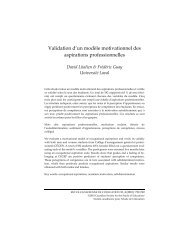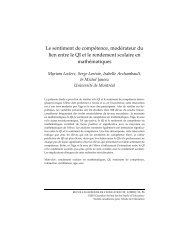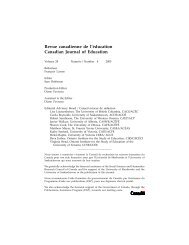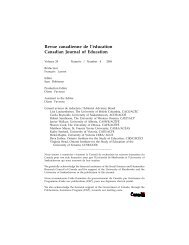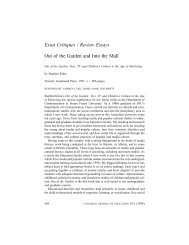Mireille Falardeau et Michel Loranger Le choix de stratégies ... - CSSE
Mireille Falardeau et Michel Loranger Le choix de stratégies ... - CSSE
Mireille Falardeau et Michel Loranger Le choix de stratégies ... - CSSE
You also want an ePaper? Increase the reach of your titles
YUMPU automatically turns print PDFs into web optimized ePapers that Google loves.
WOMEN PRINCIPALS IN BRITISH COLUMBIA 395<br />
The recent appointee loves her job and is happy to work with good teachers.<br />
She feels very lucky, and has no regr<strong>et</strong>s about her career. She wants to gain<br />
more experience as a principal, then plans for a position at the district office,<br />
either a directorship or the superinten<strong>de</strong>ncy. She advises administrative aspirants<br />
to gain credibility as teachers, and, before they become principals, to sort out<br />
their beliefs and philosophy and to <strong>de</strong>velop a vision of what they wish to accomplish.<br />
She believes they should use their unique characteristics as women to best<br />
advantage to simply be good women principals.<br />
CONCLUSION<br />
The differences we found b<strong>et</strong>ween the careers of recent and earlier women<br />
appointees to the principalship <strong>de</strong>monstrate significant changes over the last few<br />
years in the social context and work of women principals in elementary schools.<br />
Although the recent women principals we interviewed may still have to prove<br />
themselves to outsi<strong>de</strong>rs, and still do face sex-role stereotyping from soci<strong>et</strong>y as<br />
well, they are now at least accepted and supported by their male peers, unlike<br />
earlier appointees. New women principals also <strong>de</strong>monstrate greater career initiative<br />
than their earlier counterparts and are more active in their planning and pursuit<br />
of career goals; they show much less false mo<strong>de</strong>sty about their attainments<br />
and prospects. They also have a greater range of experience in both teaching and<br />
administrative areas and, aspiring to district management as they all do, their<br />
upward career orientation is greater than that of earlier appointees.<br />
The differences summarized above reflect growth and change in educational<br />
administration. Earlier female appointees were not accepted as equals by the<br />
male majority of principals with whom they worked. They remained on the outsi<strong>de</strong><br />
and chose to do so because they were not male principals and realized that,<br />
<strong>de</strong>spite effort, they could never become a natural part of the group. In proceeding<br />
to be themselves and following their own individual paths they realized that<br />
they were different. They found their own voices, their voices as women.<br />
Recent women appointees also perceive themselves as different. They have<br />
gone one step further, however, accentuating and highlighting the feminine character<br />
of their lea<strong>de</strong>rship. To apply Carol Gilligan’s (1982) phrase, these women<br />
speak collectively as principals “in a different voice.” What they clearly articulate<br />
as theirs is a lea<strong>de</strong>rship stamped by the fact that they are women. In their<br />
commentary on their lives, their experiences, and their goals these women,<br />
wh<strong>et</strong>her feminist or not, individually have articulated distinctive values and are<br />
beginning to reshape the world of educational administration to inclu<strong>de</strong> the<br />
woman’s voice.<br />
REFERENCES<br />
Adkison, J. A. (1981). Women in school administration: A review of the research. Review of<br />
Educational Research, 51, 311–343.



